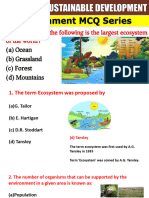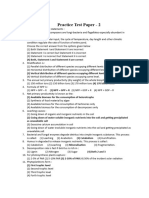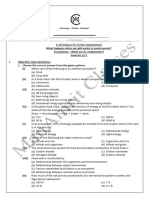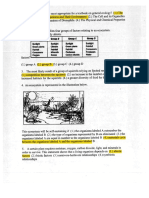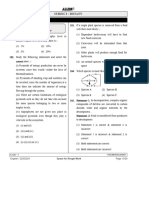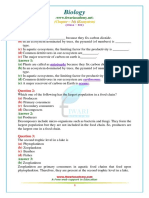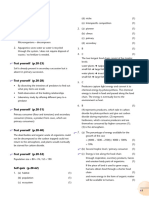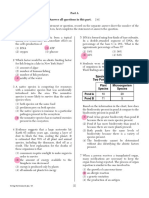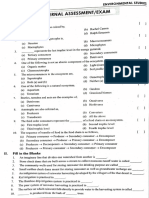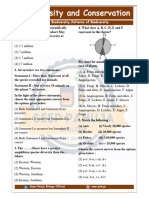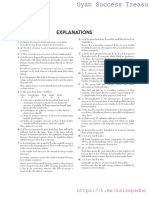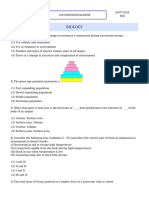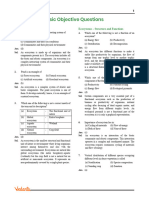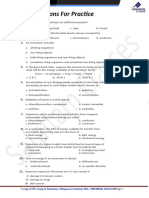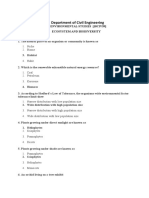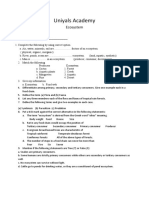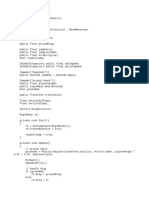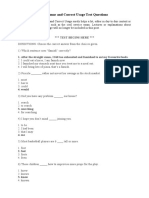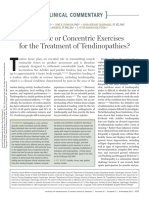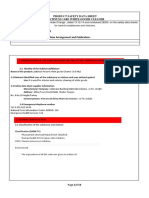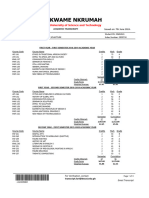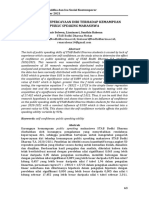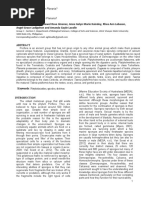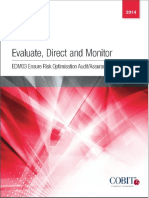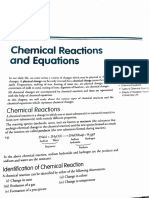0 ratings0% found this document useful (0 votes)
86 viewsEcosystem DPP by Seep Pahuja
Ecosystem DPP by Seep Pahuja
Uploaded by
nikhilnaik898Copyright:
© All Rights Reserved
Available Formats
Download as PDF, TXT or read online from Scribd
Ecosystem DPP by Seep Pahuja
Ecosystem DPP by Seep Pahuja
Uploaded by
nikhilnaik8980 ratings0% found this document useful (0 votes)
86 views4 pagesOriginal Title
Ecosystem Dpp by Seep Pahuja
Copyright
© © All Rights Reserved
Available Formats
PDF, TXT or read online from Scribd
Share this document
Did you find this document useful?
Is this content inappropriate?
Copyright:
© All Rights Reserved
Available Formats
Download as PDF, TXT or read online from Scribd
Download as pdf or txt
0 ratings0% found this document useful (0 votes)
86 views4 pagesEcosystem DPP by Seep Pahuja
Ecosystem DPP by Seep Pahuja
Uploaded by
nikhilnaik898Copyright:
© All Rights Reserved
Available Formats
Download as PDF, TXT or read online from Scribd
Download as pdf or txt
You are on page 1of 4
ECOSYSTEM
seep.pahuja Seep Pahuja Biology seep.pahuja
1. Rate of produc on of organic ma er by 3. Trees Birds Lice
producers per unit me and area is Bacteria. Thus food chain is
(1) GPP (1) Predatory
(2) NPP (2) Grazing
(3) NPP – R (3) Detritus
(4) More than one op on is correct (4) Parasi c
2. Fill in the blanks : 4. Read the following statements
regarding ecological pyramids and choose
a. Plants are called as ..... because they fix
the correct answer.
carbon dioxide.
a. Rela onship between in terms of
b. In an ecosystem dominated by trees,
organisms at different trophic levels is
the pyramid numbers is ..... type
expressed in terms of number, biomass
c. In aqua c ecosystems, the limi ng and energy.
factor for the produc vity is ....
b. Any calcula ons of energy content,
d. Common detri vores in ecosystem are biomass or number has to include only
..... one group of organisms at that trophic
e. The major reservoir of carbon on our level.
earth is .... c. In most ecosystems, all the pyramids of
(1) a-consumers, b-upright, c-temperatre, number, biomass and energy are upright.
d-earthworm, e-atmosphere d. The pyramid of biomass in sea is
(2) a-producer, b-spindle, c-light, d- generally inverted.
earthworm, e-atmosphere e. Pyramid of energy is always inverted
(3) a-producer, b-inverted, c-carbon and can never be upright.
dioxide, d-mites, e-ocean (1) a, c and d are wrong
(4) a-producer, b-inverted, c-light, d- (2) a is wrong
earthworm, e-ocean.
(3) b and e are wrong
(4) a and e are wrong
5.Which of the following trophic levels 9. In an ecosystem the func on of the
are occupied by sparrow? producers is to
(1) Primary consumer, primary producer (1) Convert organic compounds into
inorganic compounds
(2) Secondary consumer, top carnivore
(2) Trap solar energy and convert it into
(3) Primary producer, secondary producer
chemical energy
(4) Primary consumer, secondary
(3) U lize chemical energy
consumer
(4) Release energy
6. The greatest biodiversity of Earth is
found in 10. If 10,000 J of energy fall on piece of
land, then what is energy available at T2
(1) Tropical Amazonian rain forest in South
level?
Africa
(1) 1000 J
(2) Temperate Amazonian rain forest in
North America (2) 10 J
(3) Tropical Amazonian rain forest in South (3) 100 J
America
(4) 1 J
(4) Temperate Amazonian rain forest in
11. If we completely remove
South America
decomposers from an ecosystem, the
7. Choose incorrect op on w.r.t. amount ecosystem func oning will be adversely
of living material present in different affected because –
trophic levels at a given me
(1) Mineral movement will be blocked
(1) Can be measured as number
(2) Herbivores will not receive solar energy
(2) Is equivalent to standing crop
(3) Energy flow will be blocked
(3) Is always represented as dry weight
(4) Rate of decomposi on of other
only
components will be very high
(4) Expressed both as biomass and number
12. Stra fica on is well developed in
8. Ecosystem is –
(1) Tropical rain forests
(1) Any func onal unit that includes the
(2) Grasslands
whole community in a given area
interac ng with the abio c factors (3) Alpine vegeta ons
(2) A group of green plants (4) Temperate forests
(3) A group of animals interac ng with
environment
(4) Man and pets living together
13. The phenomena of one organism being 17. The respiratory loss of producers,
benefi ed without affec ng other is herbivores and carnivores are
respec vely
(1) Commensalism
(1) 10%, 20%, 30%
(2) Amensalism
(2) 20%, 30%, 60%
(3) Scavenging
(3) 20%, 40%, 80%
(4) Symbiosis
(4) Always 10%
14. The ecological pyramid of numbers in
pond ecosystem is – 18. Gross primary produc vity is –
(1) Upright (1) Rate at which organic molecules are
formed in an autotroph
(2) Inverted
(2) Rate at which organic molecules are
(3) May upright or Inverted
used up by an autotroph
(4) First upright then inverted
(3) Storage of organic molecules in the
15. Food chains differ from food webs in body of an autotroph
that
(4) Rate at which organic molecules are
(A) food chains are a single sequence of transferred to next higher trophic level
who eats whom in a community
19. A food web
(B) food chains be er represent the
(1) Increases variety of food at each
entrire community
trophic level
(C) food webs represent the complex
(2) Delicately balances the inter rela ons
interac on among food chains
amongst organisms
(D) food chain is the flow of energy in a
(3) Decreases variety of food but increases
popula on
quan ty of food at each trophic level
(1) A, C
(4) Increases variety as well as quan ty of
(2) A, D food at each trophic leve
(3) A, B, C 20. Mark the correct match
(4) A, B, C, D (1) Secondary consumer – Zooplankton
16. Least produc ve ecosystem is (2) Primary coloniser – Viruses
(1) Grassland (3) Nanoecosystem – Valley and forest
(2) Savannah (4) Omnivores – Cockroaches, Crows
(3) Forest
(4) Tundra
ANSWER KEY
1. (1) 2. (4) 3. (4) 4. (3) 5. (4) 6. (3) 7. (3) 8. (1) 9. (2) 10. (2)
11. (1) 12. (1) 13. (3) 14. (1) 15. (1) 16. (4) 17. (2) 18. (1) 19. (4) 20. (4)
You might also like
- Case in Point 4th EditionDocument185 pagesCase in Point 4th EditionieosorioNo ratings yet
- NCERT Hot Spot Chapter 16 00 00 24Document4 pagesNCERT Hot Spot Chapter 16 00 00 24srivastavakaustubh89No ratings yet
- Ecology & SDG Environment MCQ - 1Document35 pagesEcology & SDG Environment MCQ - 1puspajitnayak21No ratings yet
- Worksheet Ix Ecology Nsejs-1 230420 213823Document9 pagesWorksheet Ix Ecology Nsejs-1 230420 213823Rishabh RNo ratings yet
- Ecology Practise QuestionsDocument63 pagesEcology Practise Questionsnikhilnaik898No ratings yet
- Ecosystem DPP -2Document4 pagesEcosystem DPP -2sushmachaubey76No ratings yet
- Worksheet Ix Ecology Nsejs 230420 213848Document5 pagesWorksheet Ix Ecology Nsejs 230420 213848Rishabh RNo ratings yet
- Class 12 New TestDocument9 pagesClass 12 New Testkhan.shifu999No ratings yet
- ELP - 1 To 11 Student - Ecology - Master Pro - IA - Sir - KTN01-B4015Document17 pagesELP - 1 To 11 Student - Ecology - Master Pro - IA - Sir - KTN01-B4015roymm9091100% (1)
- Chapter Test-35 (Organisms and Populations) .Docx-1-3Document3 pagesChapter Test-35 (Organisms and Populations) .Docx-1-3thoshith.s.reddyNo ratings yet
- Ka MantraDocument3 pagesKa Mantrar.saivengadaramananNo ratings yet
- BIOLOGY - Assignment: EcosystemDocument10 pagesBIOLOGY - Assignment: Ecosystemyogesh ahireNo ratings yet
- CH 14Document26 pagesCH 14Lovely King PramothNo ratings yet
- EcosystemsDocument9 pagesEcosystemsuchihaidiot69No ratings yet
- Questions From Our EnvironmentDocument3 pagesQuestions From Our Environmentnihar.sarkar1975No ratings yet
- 15276_133745926317181607_241103131654Document5 pages15276_133745926317181607_241103131654uchihatobi4848No ratings yet
- XII N Botany Q. Paper-1Document6 pagesXII N Botany Q. Paper-1Satgonda PatilNo ratings yet
- Unit-X Chapter-14. Ecosystem: Important PointsDocument18 pagesUnit-X Chapter-14. Ecosystem: Important PointsSantosh ChavanNo ratings yet
- NCERT Hot Spot Chapter 17 00 00 24Document4 pagesNCERT Hot Spot Chapter 17 00 00 24srivastavakaustubh89No ratings yet
- OUR ENVIRONMENT -Set A AnsDocument4 pagesOUR ENVIRONMENT -Set A Ansnidishrreddy31No ratings yet
- (II) Ecology-UnlockedDocument96 pages(II) Ecology-UnlockedMANAS GOELNo ratings yet
- EcosystemDocument8 pagesEcosystemS. CheranNo ratings yet
- Ecology Review Questions 2 With AnswersDocument4 pagesEcology Review Questions 2 With AnswersJanrhey DarNo ratings yet
- Ecosystem q1Document8 pagesEcosystem q1Cosmic TextzNo ratings yet
- 12 Biology NcertSolutions Chapter 14Document9 pages12 Biology NcertSolutions Chapter 14Showkat MalikNo ratings yet
- Yan Han Shao - Questions - Regents Review QuestionsDocument7 pagesYan Han Shao - Questions - Regents Review Questionsyan han shaoNo ratings yet
- Zoology 21Document5 pagesZoology 21PranKandukuri100% (1)
- Answers: EcosystemsDocument4 pagesAnswers: Ecosystemsno moovNo ratings yet
- Living Regents ReviewDocument3 pagesLiving Regents Reviewsofia alamiaNo ratings yet
- E.V.S Importance For InternalsDocument5 pagesE.V.S Importance For Internalsunnisa2002.83No ratings yet
- NEET UG Biology EcosystemDocument18 pagesNEET UG Biology EcosystemShafana AlaudeenNo ratings yet
- Biodiversity and Conservation DPP-1Document4 pagesBiodiversity and Conservation DPP-1sushmachaubey76No ratings yet
- NCERT Solutions For Class 12 March 30 Biology Chapter 14 EcosystemDocument10 pagesNCERT Solutions For Class 12 March 30 Biology Chapter 14 EcosystemVijayalakshmi DhanabalNo ratings yet
- Unit 10 - Ecology - Revision Ws - 2 - MSDocument6 pagesUnit 10 - Ecology - Revision Ws - 2 - MSAyesha MahboobNo ratings yet
- 12 Biology Revision Questions 2017 18 Chapter 14Document10 pages12 Biology Revision Questions 2017 18 Chapter 14AbhiNo ratings yet
- Bio Sci Q&a 02Document2 pagesBio Sci Q&a 02giansulakisosuNo ratings yet
- Our Environment WorksheetDocument3 pagesOur Environment WorksheetJewel AgichaNo ratings yet
- Ecosystem EX-3txtxidtdododDocument7 pagesEcosystem EX-3txtxidtdododprakashmax008No ratings yet
- Our Environment AnsDocument7 pagesOur Environment AnsDani MathewNo ratings yet
- Our Environment Bio ImpDocument7 pagesOur Environment Bio ImpL KalyaniNo ratings yet
- Question 1275507Document9 pagesQuestion 1275507subrat swainNo ratings yet
- SolutionDocument13 pagesSolutionRajesh DhakadNo ratings yet
- B) Ernst HaeckelDocument5 pagesB) Ernst HaeckelamfismNo ratings yet
- Bio 06Document5 pagesBio 06Ajay ChoudharyNo ratings yet
- EnvironmentDocument27 pagesEnvironmentdeekshi2009reddyNo ratings yet
- Bio dpp-1 PDFDocument3 pagesBio dpp-1 PDFpremdhimanNo ratings yet
- Ecosystem EX-1gxkxkxzjkzozizrzDocument21 pagesEcosystem EX-1gxkxkxzjkzozizrzprakashmax008No ratings yet
- Biodiversity: This Section Is Taken From The BookDocument10 pagesBiodiversity: This Section Is Taken From The BookPrateek SahniNo ratings yet
- Our Environment Exampler (1)Document4 pagesOur Environment Exampler (1)Pooja GarhwalNo ratings yet
- MCQ 18civ59 1st IADocument24 pagesMCQ 18civ59 1st IASohail BaigNo ratings yet
- Selected Questions for Board ExamDocument7 pagesSelected Questions for Board Examofficialatman11No ratings yet
- Ecosystem - High Yield MCQs For NEET 2022Document10 pagesEcosystem - High Yield MCQs For NEET 2022ruhaniarora222No ratings yet
- Target Test070412Document12 pagesTarget Test070412Muthu samyNo ratings yet
- EVS CO3 AssessmentsDocument9 pagesEVS CO3 Assessmentskarimakazi313No ratings yet
- EcosystemDocument2 pagesEcosystemUniyals AcademyNo ratings yet
- Biodiversity and Conservation EX-3txjzjtstjtztzDocument5 pagesBiodiversity and Conservation EX-3txjzjtstjtztzprakashmax008No ratings yet
- 014) Ecology & Environment PYQ EbookDocument88 pages014) Ecology & Environment PYQ Ebookravirohith28No ratings yet
- Unit III-1Document9 pagesUnit III-1karimakazi313No ratings yet
- O Level Biology Practice Questions And Answers: Ecology And Our Impact On The EcosystemFrom EverandO Level Biology Practice Questions And Answers: Ecology And Our Impact On The EcosystemNo ratings yet
- Handbook of Bird BiologyFrom EverandHandbook of Bird BiologyIrby J. LovetteRating: 4.5 out of 5 stars4.5/5 (13)
- Chemical EcologyFrom EverandChemical EcologyAnne-Geneviève BagnèresNo ratings yet
- PlayerMovementTutorial CsDocument3 pagesPlayerMovementTutorial CsttfhghbhbnNo ratings yet
- Schimidt Hammer ManualDocument6 pagesSchimidt Hammer ManualScribdTranslationsNo ratings yet
- UV-Visible Spectrophotometric Method and Validation of Organic CompoundsDocument4 pagesUV-Visible Spectrophotometric Method and Validation of Organic Compoundsianatul khafidlahNo ratings yet
- Civil Service Exam Reviewer - 2aDocument67 pagesCivil Service Exam Reviewer - 2aChristopher de LeonNo ratings yet
- Statement of PurposeDocument10 pagesStatement of PurposeVivek Lal KarnaNo ratings yet
- Grade 7 Q3 WK 3Document11 pagesGrade 7 Q3 WK 3Madelyn PaitanNo ratings yet
- Adversarial Tcav - Robust and Effective Interpretation of Intermediate LayersDocument11 pagesAdversarial Tcav - Robust and Effective Interpretation of Intermediate LayersJack LiNo ratings yet
- 2015 Eccentric or Concentric Exercises For The Treatment of Tendinopathies...Document11 pages2015 Eccentric or Concentric Exercises For The Treatment of Tendinopathies...Castro WeithNo ratings yet
- E Rpms Portfolio Design 8 DepedclickDocument42 pagesE Rpms Portfolio Design 8 DepedclickJayson Manuel L OsongNo ratings yet
- Familiarization With Apparatus - EquipmentDocument61 pagesFamiliarization With Apparatus - EquipmentGray CrimsonNo ratings yet
- THC 115 - Module For Week No. 7Document16 pagesTHC 115 - Module For Week No. 7Tea cherNo ratings yet
- Rivaldo Kogoya - 30.1501 - Implementasi Kebijakan Penanganan Stunting Di Kecamatan Tagime Kabupaten Jayawijaya Provinsi PapuaDocument10 pagesRivaldo Kogoya - 30.1501 - Implementasi Kebijakan Penanganan Stunting Di Kecamatan Tagime Kabupaten Jayawijaya Provinsi PapuaDidi PokiroNo ratings yet
- Construction and Building Materials: Jacek Katzer, Jacek DomskiDocument6 pagesConstruction and Building Materials: Jacek Katzer, Jacek DomskiLúcio BarbozaNo ratings yet
- Transfer Essay SampleDocument5 pagesTransfer Essay Samplexlfbsuwhd100% (2)
- White Goods Cleaner MSDS (2742)Document10 pagesWhite Goods Cleaner MSDS (2742)Alamana CmeNo ratings yet
- Advanced Network Adjustment - Leica InfinityDocument18 pagesAdvanced Network Adjustment - Leica InfinityShanmukh GollapudiNo ratings yet
- Essay Meaning and TranslationDocument10 pagesEssay Meaning and TranslationirmamafatihulhusnaNo ratings yet
- Orbital Dynamics in Galactic Potentials Under Mass Transfer: Eduárd Illés, Dániel Jánosi, and Tamás KovácsDocument13 pagesOrbital Dynamics in Galactic Potentials Under Mass Transfer: Eduárd Illés, Dániel Jánosi, and Tamás Kovácswalidbenali31000No ratings yet
- SignupDocument13 pagesSignuppearl ikebuakuNo ratings yet
- SYLVESTER AGYAKU LANYO-KnustTranscript-LS42509EBDDocument3 pagesSYLVESTER AGYAKU LANYO-KnustTranscript-LS42509EBDlanyosylvesterNo ratings yet
- The Lost Generation by Shandana Minhas - October 8, 1998 (Chowk - Com)Document7 pagesThe Lost Generation by Shandana Minhas - October 8, 1998 (Chowk - Com)theselongwarsNo ratings yet
- International Code of Nomenclature For Algae, Fungi, and PlantsDocument12 pagesInternational Code of Nomenclature For Algae, Fungi, and PlantsGrahamNo ratings yet
- Optimising Your Sleep v2Document15 pagesOptimising Your Sleep v2jaikwamNo ratings yet
- Pengaruh Kepercayaan Diri Terhadap Kemampuan Public Speaking MahasiswaDocument7 pagesPengaruh Kepercayaan Diri Terhadap Kemampuan Public Speaking MahasiswaIcang 01No ratings yet
- Webinar Understanding and Implementing Decision Rules in The New ISO-IEC 17025Document40 pagesWebinar Understanding and Implementing Decision Rules in The New ISO-IEC 17025Selyun E OnnajNo ratings yet
- Porifera and PlatyhelminthesDocument12 pagesPorifera and PlatyhelminthesJahlen JardelezaNo ratings yet
- Story Map - Autopsy Room 4Document1 pageStory Map - Autopsy Room 4Maria Camila Salcedo OliverosNo ratings yet
- EDM03 Ensure Risk Optimisation Audit Assurance Program - Icq - Eng - 0214Document29 pagesEDM03 Ensure Risk Optimisation Audit Assurance Program - Icq - Eng - 0214ssglcnNo ratings yet
- All in One Science Class 10Document25 pagesAll in One Science Class 10Manjushri SoniNo ratings yet


